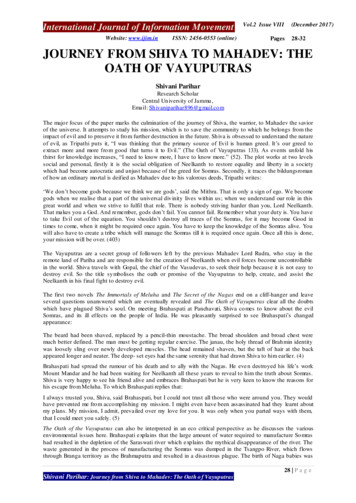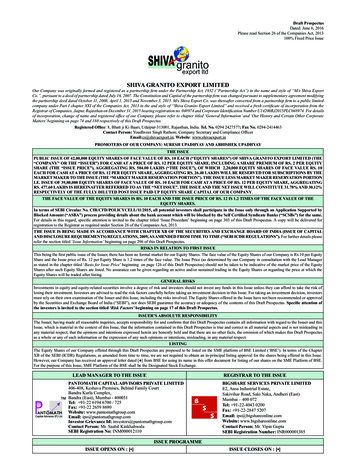
Transcription
International Journal of Information MovementWebsite: www.ijim.inISSN: 2456-0553 (online)Vol.2 Issue VIII(December 2017)Pages28-32JOURNEY FROM SHIVA TO MAHADEV: THEOATH OF VAYUPUTRASShivani PariharResearch ScholarCentral Un iversity of Jammu ,Email: Sh ivaniparihar896@g mail.co mThe majo r focus of the paper marks the culmination of the journey of Shiva, the warrior, to Mahadev the saviorof the universe. It attempts to study his mission, which is to save the community to which he belongs from theimpact of evil and to preserve it fro m further destruction in the future. Sh iva is obsessed to understand the natureof evil, as Tripathi puts it, “I was thinking that the primary source of Evil is human greed. It’s our greed toextract more and more fro m good that turns it to Evil.” (The Oath of Vayuputras 133). As events unfold histhirst for knowledge increases, “I need to know more, I have to know more.” (52). The plot works at two levelssocial and personal, firstly it is the social obligation of Neelkanth to restore equality and liberty in a societywhich had become autocratic and unjust because of the greed for Somras. Secondly, it traces the bildungsromanof how an ordinary mo rtal is deified as Mahadev due to his valorous deeds, Tripathi writes:‘We don’t become gods because we think we are gods’, said the Mithra. That is only a sign of ego. We becomegods when we realise that a part of the universal div inity lives within us; when we understand our role in thisgreat world and when we strive to fulfil that role. There is nobody striving harder than you, Lord Neelkanth.That makes you a God. And remember, gods don’t fail. You cannot fail. Remember what your duty is. You haveto take Evil out of the equation. You shouldn’t destroy all traces of the Somras, for it may become Good intimes to come, when it might be required once again. You have to keep the knowledge of the Somras alive. Youwill also have to create a tribe which will manage the Somras till it is required once again. Once all this is done,your mission will be over. (403)The Vayuputras are a secret group of follo wers left by the previous Mahadev Lord Rudra, who stay in theremote land of Pariha and are responsible for the creation of Neelkanth when evil forces become uncontrollablein the world. Shiva travels with Gopal, the chief o f the Vasudevas, to seek their help because it is not easy todestroy evil. So the title sy mbolises the oath or promise of the Vayuputras to help, create, and assist theNeelkanth in his final fight to destroy evil.The first two novels The Immortals of Meluha and The Secret of the Nagas end on a cliff-hanger and leaveseveral questions unanswered which are eventually revealed and The Oath of Vayuputras clear all the doubtswhich have plagued Shiva’s soul. On meeting Brahaspati at Panchavati, Shiva co mes to know about the evilSomras, and its ill effects on the people of India. He was pleasantly surprised to see Brahaspati’s changedappearance:The beard had been shaved, replaced by a pencil-thin moustache. The broad shoulders and broad chest weremuch better defined. The man must be getting regular exercise. The janau, the holy thread of Brah min identitywas loosely sling over newly developed muscles. The head remained shaven, but the tuft of hair at the backappeared longer and neater. The deep- set eyes had the same serenity that had drawn Shiva to him earlier. (4)Brahaspati had spread the rumour of his death and to ally with the Nagas. He eve n destroyed his life’s workMount Mandar and he had been waiting for Neelkanth all these years to reveal to him the truth about Somras.Shiva is very happy to see his friend alive and embraces Brahaspati but he is very keen to know the reasons forhis escape fro m Meluha. To wh ich Brahaspati replies that:I always trusted you, Shiva, said Brahaspati, but I could not trust all those who were around you. They wouldhave prevented me fro m acco mplishing my mission. I might even have been assassinated had they learnt aboutmy p lans. My mission, I admit, prevailed over my love for you. It was only when you parted ways with them,that I could meet you safely. (5)The Oath of the Vayuputras can also be interpreted in an eco critical perspective as he discusses the variousenvironmental issues here. Brahaspati explains that the large amount of water required to manufacture So mrashad resulted in the depletion of the Saraswati river which exp lains the mythical disappearance of the river. Thewaste generated in the process of manufacturing the Somras was dumped in the Tsangpo River, which flowsthrough Branga territory as the Brahmaputra and resulted in a disastrous plague. The birth of Naga babies was28 P a g eShivani Parihar: Journey from Shiva to Mahadev: The Oath o f Vayuputras
International Journal of Information MovementWebsite: www.ijim.inISSN: 2456-0553 (online)Vol.2 Issue VIII(December 2017)Pages28-32also credited to Somras as it resulted in the multiplication of cells at a very high rate which lead to theirdeformation and outgrowths at birth. Sh iva understands why, “So mras has tipped over fro m the greatest Good tothe greatest Evil.”(6).Shiva travels to the hidden city of Ujjain along with his entourage to meet the chief of Vasudev pandits, Gopal.He explains how the Vayuputra council, an ancient tribe left by the previous Mahadev Lord Rudra, dwelt theremote land of Pariha in the West and trained a member of their tribe as the Neelkanth when "evil" rises. Hindumythology revolves around the notion of the good and evil, just as we only need light when we are in darkness,we can understand the value of good only when there is evil to compare it with. There is a place for everythingin the universe—good and evil, happiness and sorrow, and life and death. In all the epics of Hindu mythology,the concept of nemesis plays an integral part for every ‘Kansa’ there is a ‘Krishna’ and for every ‘Ravana’ thereis a ‘Rama’. There is no denying the fact that the evil plays a key role in bringing out the good. Shivaunderstands that it was his uncle Manobhu, who turns out to be a former Vayuputra member, trained him asNeelkanth for this very purpose. Seeing that Meluha is the centre of manufacturing the Somras, Shiva declares aholy war on the kingdom and appeals to the people to stop using the drink. Parvateshwar decides to join Meluha,since he thinks that it is his duty to defend his motherland, so does Anandmayi. Sh iva also realizes thatMaharishi Bhrigu is the mastermind behind the attack on Panchavati, plotting against him along with theSwadweepan emperor Dilipa and Daksha. As Shiva prepares for a series of battles the rulers of Branga, Vaishaliand Kashi come to his aid. He takes the Nagas, the Brangas and the Vasudev eleph ant corps to attack Meluha,while Kart ik and Ganesh attack Ayodhya and successfully and prevent them fro m aiding Meluha. Shivacaptures the city of Mrittikavatti and makes the citizens imprison the Meluhan army led by Vidyunmali, whobelieves Shiva to be a fraud. He manages to escape and persuade Bhrigu and Parvateshwar to attack Sati's armywith a thousand Meluhan troops, and defeats her.Following this defeat, Shiva abandons the plan of invading Meluha and leaves for Pariha with Gopal; he wantsto procure the deadly Brah mastra weapon, to threaten the Meluhans into making peace with them. There hemeets the chief of Vayuputras, Mithra, who turns out to be his maternal uncle. Mithra convinces the Vayuputrasthat Shiva is the real Neelkanth and gives him the Pashupathiastra which acts on a specific target, rather thanannihilating everything like the Brah mastra. Meanwhile, Parvateshwar uses decoy ships to give an impression toKali that he was going to attack Panchavati. Alarmed, Kali takes the bait and leav es with the finest Nagasoldiers in their pursuit, however, she realizes her folly and returns.Daksha plans to assassinate Shiva and sends Vidyunmali to get Egyptian assassins. He frames a peace treaty forShiva but in his absence, Sati attends the peace conference and finds out the truth. She fights the assassinsvaliantly, but is killed. The war ends with Sati's death, but an enraged Shiva decides to use the Pashupatiastra tofin ish Devagiri forever. Parvateshwar, Anandmayi, Veerini decide to stay back in the city and die with it, butKartik persuades Bhrigu to remain alive and share his vast knowledge with future generations. Shiva unleashesthe astra and ends Devagiri's history, along with the So mras manufacturing units hidden beneath the city.In the epilogue, Shiva ret ires to Mount Kailash where he lives the rest of his days peacefully, though missingSati every day. Tripathi has retold the Shivpurana in a brilliant way and this sort of experimentation with Indianmythology was long overdue his concept of myth- thriller. During an interview with Daily News and Analysis,Tripathi says:He had purposefully used the modern terms for the d ifferent historical locations described in the book, includingcalling India by its name, rather than its ancient name, Jambudweep. He did not believe that India could berepresented as a political concept in his book, since at the timeline followed in the Sh iva trilogy, India was still acultural concept.”(Krishna, 3)Some of the characters retain their mythological names, but do not follow the characteristic traits of the mythicalcharacters. The author said: “When I was writ ing the first book, I was struggling with the Naga, because Iwanted to desperately change his character – that he should be jovial and happy. But he kept ending up as atormented and troubled a guy who was suffering. Popular Cu lture Studies celebrate the frag mented, the plural,the contingent and the local while reject ing universals and totalities.”(3). It sees representation as an end in itselfcalls into question the notion of a truth and collapses the distinction between original and copy. This is whatAdorno says:The whole world is made to pass through the filter of the culture industry. The illusion is created that the outsideworld is a straightforward continuation of what is presented on the screen. Real life beco mes indistinguishablefro m the mov ies which leave no room for imagination or reflect ion, confronting the spectator with a rush offacts, precluding any space for sustained thought. (Dialectic of Enlightenment, 126-127)29 P a g eShivani Parihar: Journey from Shiva to Mahadev: The Oath o f Vayuputras
International Journal of Information MovementWebsite: www.ijim.inISSN: 2456-0553 (online)Vol.2 Issue VIII(December 2017)Pages28-32Although, Adorno is talking about movies and screen, but it also applies to this novel where we get so muchinvolved in the episodes and incidents that we think this is the truth thus myth becomes transposed to a popularcontemporary content.All cultures have expressed mythical quest for an ideal state in terms of their hopes, dreams, imperial ambit ion,as well as highest state of grace, in such concepts as “Utopia”, “Promised Land”, “Kingdom of Heaven”, “IdealRepublic”, “Krita Yuga” or “Ram- Rajya” and the instrument for such transformation is an “Avatara”,“Bodhisattva”, “Visionary Seer”, a “Mahatma”, or a “Neelkanth”. Shiva despite being a co mmon man hasmany heroic attributes as depicted in W.H Auden’s essay, “The quest hero”, “He resemb les the hero of themodern world, a man of hidden powers, intelligence and trustworthy” (31). In a wo rld of evil he is capable ofradiating the invisible message of goodness, truth and justice to the people. When the Meluhans respect him asNeelkanth, he is not happy with the title and wants to know the reason behind it.‘Who is Neelkanth?’ this question has been raised many times in the novel by the Meluhans, Gopal (Vasudev),and also by the main protagonist “Shiva” himself. Gopal is the mentor who enters Shiva’s life to explain thesource of evil and to tell him that he has to bring it to an end. It is Gopal who makes Shiva aware of the fact thathe is not an ordinary person, but a hero who has before him the awesome task of saving the world fro m thechaos generated by the imbalance of evil overpowering the good.It has been defined that Vasudev are the tribe left behind by the previous Vishnu they are a secretive group ofpriests who wait through the millennia to assist the Neelkanth in destroying evil, whereas Vayuputras are thetribe left behind by the previous Mahadev, Lord Rudra. Both work to facilitate the arrival of Neelkanth, andmentor/assist him in the battle against evil forces represented by Daksha and Dilipa. The novel is named afterVayuputras and their oath; they are assigned the work of finding the “evil” in the society and the next great“good” in the world. It is the duty of the Vayuputra to control the institution of the Neelkanth, they train theelig ible candidate fo r the ro le of Neelkanth and if they believe that evil has risen, they allow the identification ofa Neelkanth. Gopal tells Shiva that they administer some medicine to the candidates as he enters adolescence.The effect of the med icine remains dormant in his throat for years till it manifests itself on his drinking theSomras at a specific age. When the Somras is given and it reacts with the traces of the medicine already presentin the man’s throat it makes the neck appear blue. All of the activit ies have to be done at specific time period inthe man’s life if, this is to happen the way it has been conceptualized. For examp le, if a man drinks the Somrasmore than fifteen years after adolescence, his throat will not turn blue even if he has taken th e Vayuputramed icine as a child. People’s blind faith in the legend would ensure that they would follow the Neelkanth andevil would be taken out of the equation. Shiva was shocked to hear since he is not the member of the Vayuputratribe how did he suddenly emerge out of nowhere:Yes. Nobody really understood what had happened. We knew you were not a Vayuputra authorised candidate.Many Vayuputra infact believed that you were
Shivani Parihar: Journey from Shiva to Mahadev: The Oath of Vayuputras OATH OF VAYUPUTRAS Shivani Parihar Research Scholar Central University of Jammu, Email: Shivaniparihar896@gmail.com The major focus of the paper marks the culmination of the journey of Shiva, the warrior, to Mahadev the savior of the universe. It attempts to study his mission, which is to save the community to which he











